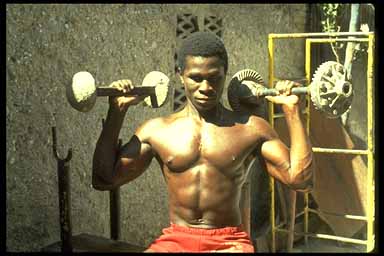|
Summer Special!
Two Months Free Membership !
If I was allowed only five words to describe the Haitian people, two of them would be “ingenious” and ‘resourceful.”
In downtown Port-au-Prince many of the main streets have alleys branching off them. These are labyrinthine affairs that wind around and around into the innards of the block. It’s crowded in there, densely packed with small dwellings- wooden shacks and cinderblock houses, all set right up against one another. Thousands of people live in the small space and the life is lively. There are young girls braiding one another’s hair, little boys spinning homemade hoops or kicking balls made of tied-up newspaper and women squatting to wash clothes in small tin basins or to cook aromatic meager meals over small charcoal braziers. Whenever Haitians assemble, there’s a riot of sound: radios are playing, people are singing, but most of all, they are just speaking their remarkably musical native language, Haitian Creole. Eavesdropping on a conversation among two or three excited Haitians is like attending a piece of animated performance art.
Considering how many people live in a limited area, it is fairly clean in there; whenever Haitians have any control over their space, it is immaculate. You rarely see trash or garbage in or around a Haitian’s home: there are a few smelly spots, like the latrine and the local dump, but that is because there is no running water and the Department of Sanitation, if there is one, never comes around to pick up the garbage or pump out the potty. These areas are putrid indeed and breed plenty of rats, which are a fact of life in most of Haiti.
Some years ago, my wife Madeline and I were exploring one of these alleys, looking for a certain artist. We were hopelessly lost when we came to a small open area that was set up with some homemade iron stands. There were a few young men in there. We were amazed to see that they were working out, lifting weights and doing chinups. We stopped to ask them if they knew the artist and as we were chatting we noticed that the weights were mostly homemade too; they were constructed from old auto parts like brake drums and universal joints and various flywheels and smaller metal cogs. Madeline asked the kid what the place was. He spread his palms in a gesture grand enough to include the area and with a huge grin said, “ Spa!, sa se un spa!.” We all cracked up, especially the Haitians.
It’s things like this that make us fall in love with Haiti. I do not mean to trivialize or romanticize the harsh conditions that many Haitians live with, but only to make the point that under conditions that are truly crushing, most Haitians are not crushed, but manage to make the best of a bad situation with optimism and good humor.
|
|







